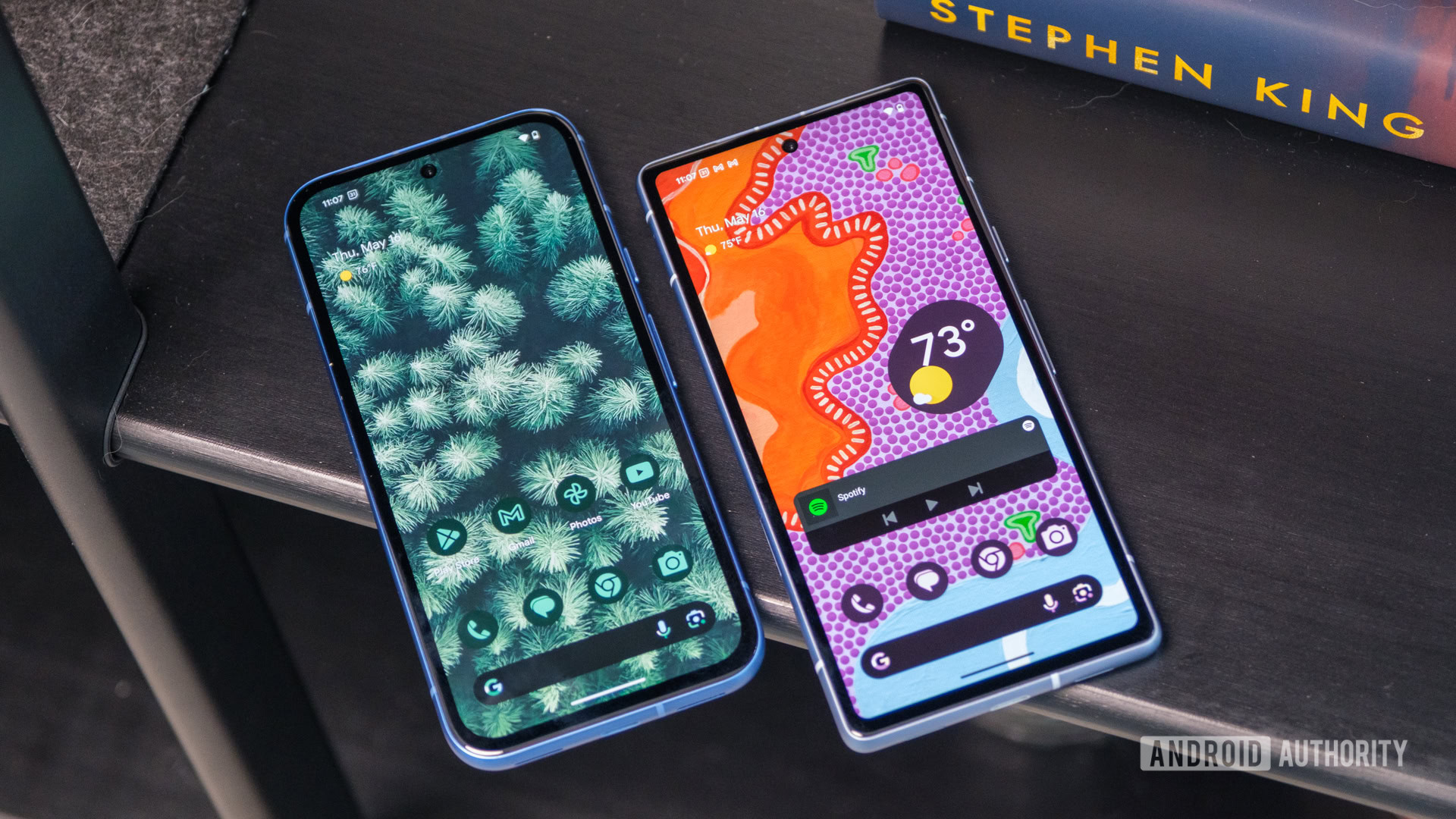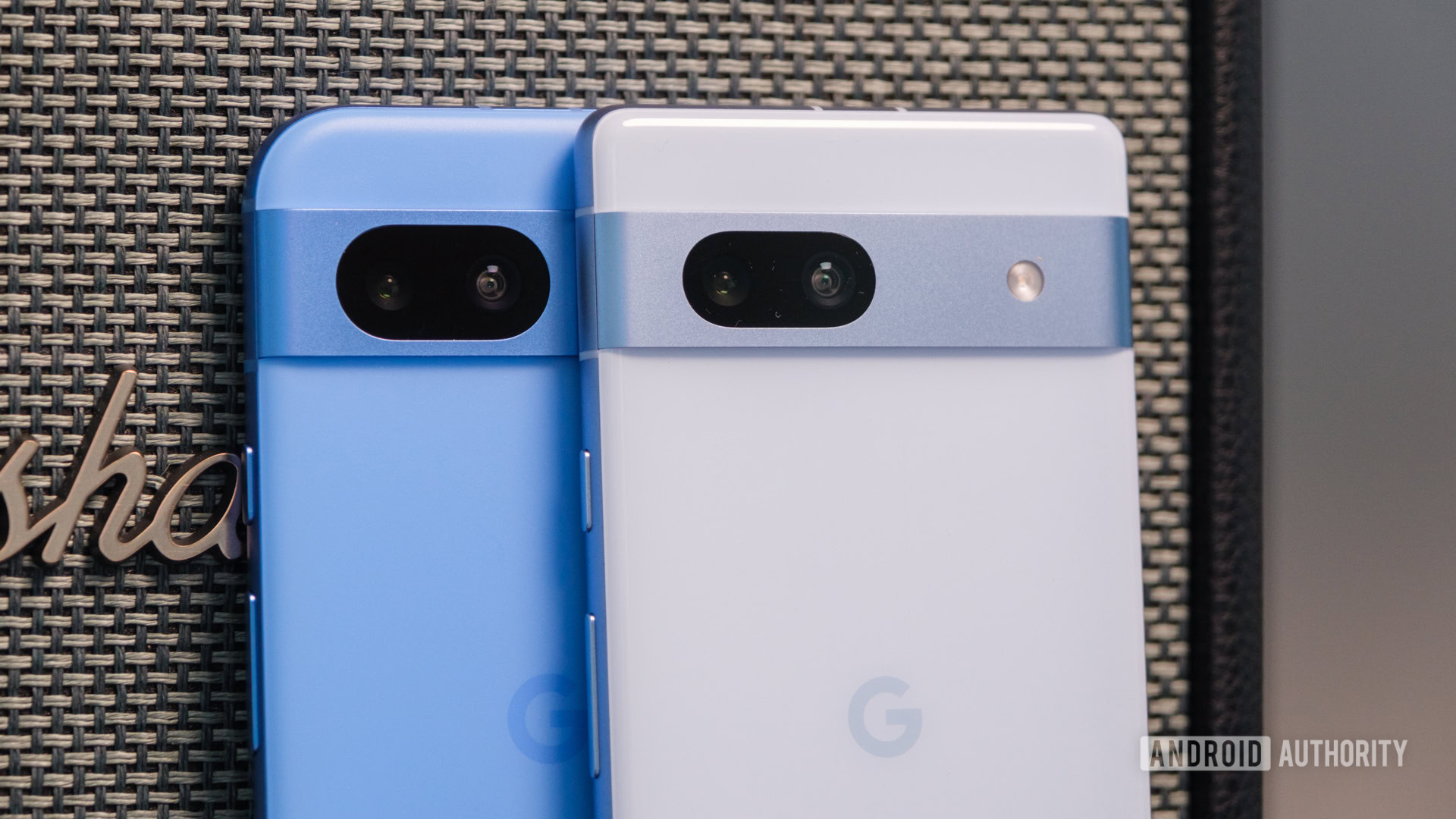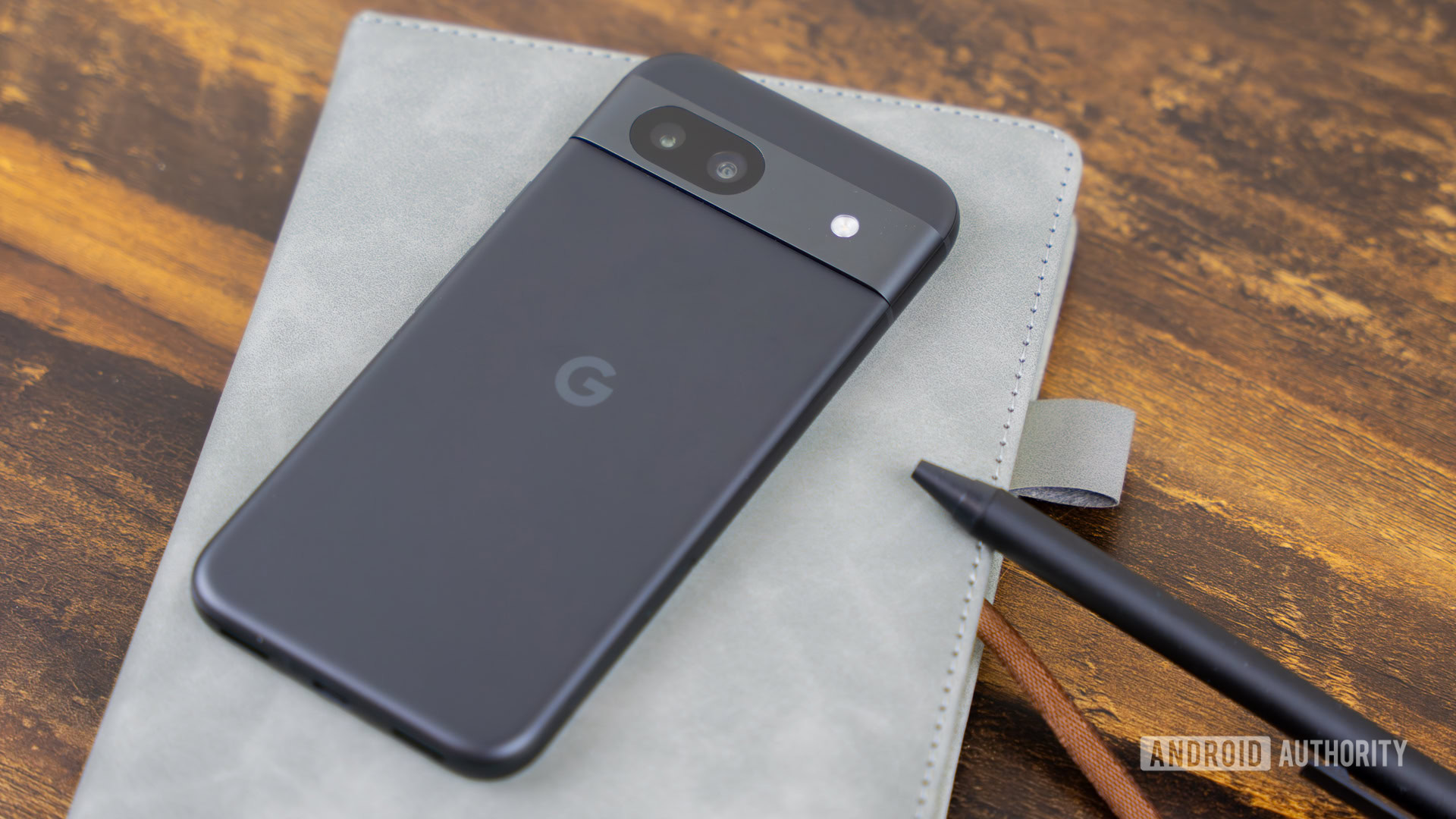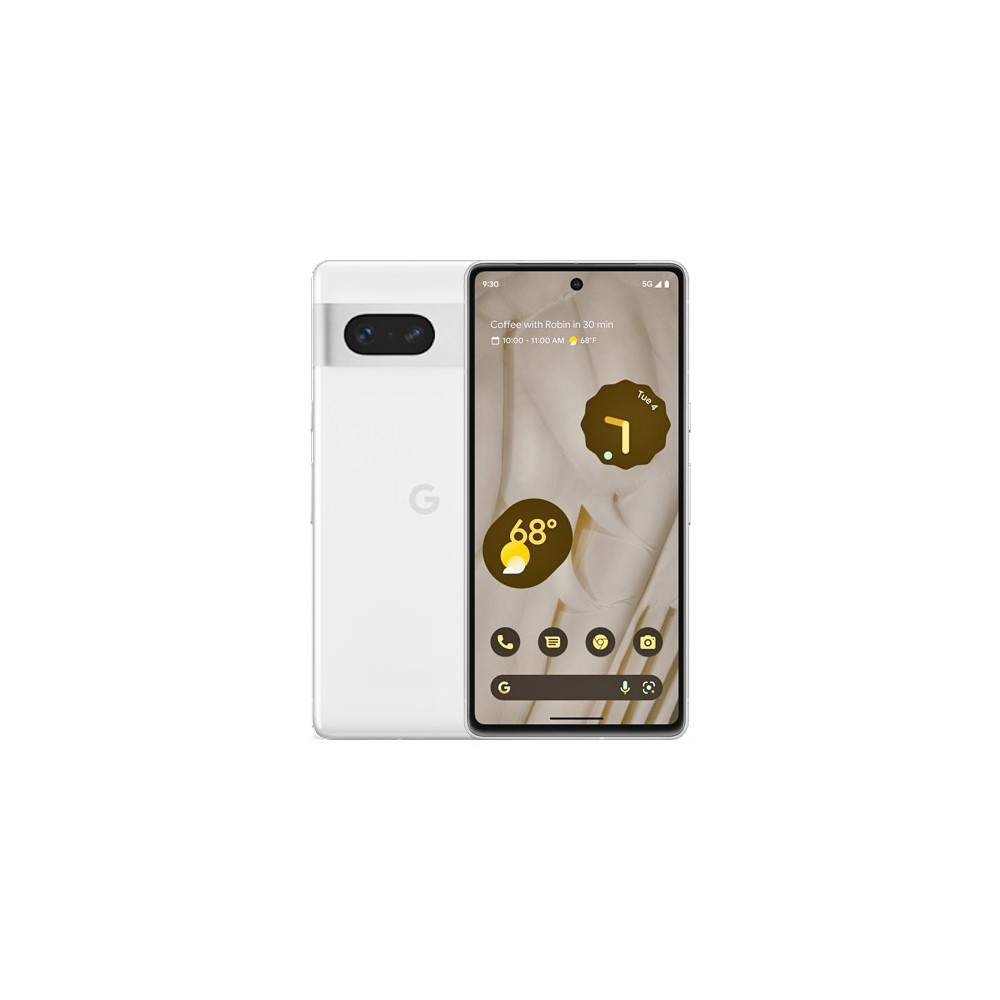Affiliate links on Android Authority may earn us a commission. Learn more.
Google Pixel 7a vs Pixel 8a: What's new and should you upgrade?
Published onMay 23, 2024
Google’s Pixel A series is the best line of mid-range Android phones around. It’s an easy, relatively affordable way to get your hands on almost all of the flagship Pixel experience without breaking the bank. Even still, the Pixel A series has grown and changed over the years, swapping its headphone jack and rear-mounted fingerprint reader for a camera bar and a Tensor chip, so it can be challenging to know when it’s time to upgrade.
Now that the Google Pixel 8a is on the market, Pixel 7a owners might be feeling that familiar itch to buy a new phone. Plus, with the Pixel 7a still broadly on sale at the time of writing, now is a good time to compare the Google Pixel 7a vs Google Pixel 8a to see which is right for you.
Google Pixel 7a vs Google Pixel 8a: At a glance
- The Google Pixel 8a is slightly more powerful than the Pixel 7a, thanks to its Tensor G3 chipset.
- Both the Google Pixel 7a and Pixel 8a start at the same price: $499.
- The Google Pixel 7a and Pixel 8a share the same 64MP primary and 13MP ultrawide camera sensors.
- The Google Pixel 8a will get more years of software support than the Pixel 7a.
- The Pixel 7a and Pixel 8a support the same 18W wired and 7.5W wireless charging speeds.
- The Google Pixel 8a has a matte plastic back in place of the Pixel 7a's glossy plastic.
Google Pixel 7a vs Google Pixel 8a: Specs
| Google Pixel 8a | Google Pixel 7a | |
|---|---|---|
Display | Google Pixel 8a 6.1-inch OLED 120Hz refresh rate 2400 x 1080 resolution 20:9 aspect ratio | Google Pixel 7a 6.1-inch OLED 90Hz refresh rate 2400 x 1080 resolution 20:9 aspect ratio |
Processor | Google Pixel 8a Google Tensor G3 | Google Pixel 7a Google Tensor G2 |
RAM | Google Pixel 8a 8GB | Google Pixel 7a 8GB |
Storage | Google Pixel 8a 128/256GB | Google Pixel 7a 128GB |
Battery | Google Pixel 8a 4,492mAh 18W wired charging 7.5W wireless charging No charger included | Google Pixel 7a 4,385mAh 18W wired charging 7.5W wireless charging No charger included |
Cameras | Google Pixel 8a Rear: 64MP wide camera ƒ/1.89 aperture OIS + EIS 13MP ultra-wide camera, 120deg FoV ƒ/2.2 aperture Front: 13MP ƒ/2.2 aperture | Google Pixel 7a Rear: 64MP wide camera ƒ/1.89 aperture OIS + EIS 13MP ultra-wide camera, 120deg FoV ƒ/2.2 aperture Front: 13MP ƒ/2.2 aperture |
Connectivity | Google Pixel 8a 5G 4G LTE Wi-Fi 6e Bluetooth 5.3 NFC | Google Pixel 7a 5G 4G LTE Wi-Fi 6e Bluetooth 5.3 NFC |
Operating System | Google Pixel 8a Pixel UI Android 14 | Google Pixel 7a Pixel UI Android 13 (Updated to Android 14) |
Water resistance | Google Pixel 8a IP67 | Google Pixel 7a IP67 |
Colors | Google Pixel 8a Aloe, Bay, Obsidian, Porcelain | Google Pixel 7a Sea, Charcoal, Snow, Coral |
Dimension and weight | Google Pixel 8a 152.1 x 72.7 x 8.9mm 188 grams | Google Pixel 7a 152 x 72.9 x 9mm 193.5 grams |
Comparing any recent Google Pixel device is a tricky game of apples to apples, but the Pixel 8a and Pixel 7a sit even closer than most. Although there are a few year-over-year upgrades, the two phones are almost the same size, offer the same RAM and storage, and carry nearly the same battery and charging setups. Some might say that makes it easy to grab the newer device, but there’s more to this comparison than that.
Perhaps the Pixel 8a’s most important advantage over its predecessor is its adoption of Google’s newer Tensor G3 chipset. It’s more powerful than the previous Tensor G2 and seems to handle its thermal performance much better — something we’ve begged Google for since the original Tensor chip landed. The new chipset easily outpaced its predecessor in our controlled benchmark testing, with considerable upgrades in graphics performance. As you can see in both graphs, the Tensor G3 sits comfortably ahead of the G2 whether you’re leaning on the CPU or GPU.
That means the newer Pixel 8a is a better bet if you’re a mobile gamer or otherwise put your phone under heavy stress. We could dip into titles like Asphalt 9 and Warhammer 40,000 Tacticus for longer stretches without feeling like the phone’s aluminum frame wanted to burn its way out of our hands. Granted, you might not notice the difference as much during casual usage, like scrolling social media or browsing the web, but I’ve appreciated the extra power when needed.
The newer Pixel 8a also ships with Android 14 right out of the box, a full version ahead of Android 13 that shipped on the Pixel 7a. Granted, the older phone received its Android 14 update before the Pixel 8a launched, but it will also run out of update support several years sooner. The Pixel 8a offers the same impressive seven-year commitment you get on the Pixel 8 and 8 Pro, which puts it ahead of similarly priced rivals and even most flagships. In contrast, the Pixel 7a gets three years of Android updates and five years of security patches.
Despite the differences in software support, the current Pixel UI experience is identical on both phones. Whether you opt for the Pixel 7a or Pixel 8a, you’ll get Pixel-exclusive mainstays like Live Translate, Hold for Me, and Call Screen, as well as new tricks like Circle to Search and Audio Emoji — which essentially acts like a reaction soundboard for phone calls.
Google Pixel 7a vs Google Pixel 8a: Design, size comparison, and colors

In addition to their similar hardware, the Pixel 7a and Pixel 8a are almost the same size. Honestly, if I didn’t have both devices in front of me, I’d struggle to tell them apart. The Pixel 8a is a fraction of a millimeter taller, but the Pixel 7a is wider by about the same margin, and the two phones are evenly matched at their widest point — the camera bar. However, once you put them next to each other, the Pixel 8a’s rounded edges make it feel smaller and more comfortable in hand than its predecessor.
While the Pixel 7a isn’t necessarily sharp around the edges, it does come to more of a point in the corners, which can dig into the palm of your hand over time. The Pixel 8a, on the other hand (pun intended), feels a bit closer to the roundness of the Pixel 8 Pro, which I much prefer. It’s lighter than the Pixel 7a, too, but only by about five grams, so you won’t notice unless you hold the two phones side by side.
They're only fractions of millimeters apart, but the Pixel 8a's round corners make it feel much smaller in the hand.
Personally, I much prefer the Pixel 8a’s matte composite back to the glossy material of the Pixel 7a. Both are made of plastic and protected by aluminum frames, but the Pixel 8a is fingerprint-proof, while the Pixel 7a is a smudge magnet.
Despite their slightly different shapes, you could probably find your way around the Pixel 7a and Pixel 8a with your eyes closed. The two mid-rangers share the same button layout, with the volume rocker and power button on the right side and the single nano-SIM tray on the left. The stereo speakers flanking the USB-C port are a perfect match, and so is the in-display fingerprint reader. I haven’t noticed one registering my fingerprint faster than the other — both are snappy with just enough haptic feedback.
Sometimes, you can use color options to tell two phones apart, but not in this case. Google introduced its Pixel 7a with three standard options: Sea, Charcoal, and Snow, with a Google Store exclusive Coral — essentially blue, black, white, and orange. Then, it rolled out the Pixel 8a in Bay, Obsidian, and Snow, each almost a perfect match for Sea, Charcoal, and Snow, but swapped Coral for a bright green Aloe.
Flipping around to the display, Google’s newer Pixel 8a has a few upgrades that make it a little more worthwhile. The first is that it swaps from a fixed 90Hz panel to a 60 to 120Hz variable one, giving it more adaptability for different tasks. The Pixel 8a comes locked to 120Hz right out of the box, which means it feels much smoother in hand than its predecessor. Though not a drastic change, swiping through my Google Discover feed and keeping up with the latest tech gossip on X flowed just a bit nicer on the Pixel 8a. Google’s new Actua Display is also noticeably brighter, topping out at 2,000 nits of peak or 1,400 nits of HDR brightness.
Both displays are the same size, 6.1 inches, though, and offer the same 1,080 x 2,400 resolution. They’re also made of Gorilla Glass 3, which is decent but doesn’t quite live up to the $500 price tag in 2024, especially when Samsung’s more affordable Galaxy A35 uses Gorilla Glass Victus Plus on both front and back. Both mid-range Pixels have IP67 ratings against water and dust.
Google Pixel 7a vs Google Pixel 8a: Camera

Moving on to cameras, the Pixel 8a and 7a are once again pretty evenly matched, at least regarding hardware. The budget camera bars look the same, with equal thickness and brushed aluminum finishes, and they share the same set of wide and ultrawide sensors. Both phones rely on a 64MP primary sensor for most of their shooting, though it’s backed by a 13MP ultrawide snapper with a just-right 120-degree field of view. The primary sensors share a maximum aperture of ƒ/1.9, and both bin to 16MP shots by default.
Google’s mid-range Pixel cameras aren’t just twins on paper, either; many of our samples from the two phones are almost impossible to distinguish. We took them for a quick spin around town, testing the zoom capabilities, portrait mode detection, and selfie cameras, and it’s tough to find much daylight between the two. The Pixel 8a and Pixel 7a were spot on when recreating the red hues in the springtime leaves, and they nailed the portrait mode edge detection around the statue of two children.
Unfortunately, the reliance on wide and ultrawide cameras means that both phones start to come up short at the same time — once you zoom in. They lose many of their finer details once you get to 4x zoom or max out at 8x zoom. For example, both phones lose sharpness in the name of the boat at 8x zoom, and the rocks in the background look more like a painting than a photo. For what it’s worth, the Pixel 8a is more color-accurate in the sample, though.
Selfie performance is a little different despite the phones sharing the same 13MP punch hole sensor. The details and colors match, but the Pixel 7a punches in just a bit closer for its default zoom, limiting how much you can fit into the frame with you.
However, Google’s Tensor G3-based software features help set the two phones apart a bit better. While the Pixel 8a and Pixel 7a share several staples like Magic Eraser, Cinematic Pan, Night Sight, and Photo Unblur, only the newer device gets extras like Ultra HDR, Best Take, and Audio Magic Eraser for removing unwanted sounds from videos. You’ll need the Google Photos app for several of the cloud-based editing tricks, but it comes installed by default on both phones.
Also, despite missing Audio Magic Eraser, the Google Pixel 7a supports the same video recording options as its successor. You can record in either 1080p or 4K resolution at up to 60fps from either rear camera or at 30fps from the selfie camera, and both Pixels are capable of slow motion at up to 240fps. I noticed that Google’s image stabilization seems much better on the Pixel 8a while walking and recording, so if you’re planning to shoot a lot of videos, that might be the way to go.
Google Pixel 7a vs Google Pixel 8a: Battery life and charging
The Pixel 8a also comes out just ahead of the Pixel 7a in battery life and charging, which is interesting because the two phones share the same wired and wireless charging speeds. Google’s newer Pixel has a slightly larger battery, around 100mAh, but it charged from empty to full five minutes faster in our wired charging test. I’ve mostly been charging the devices with Adaptive Charging overnight, so I haven’t noticed the time savings in my day-to-day life, but it’s nice to see Google pick up the pace a bit — even if that pace is still achingly slow compared to the competition.
Of course, we started both Pixels at their full 18W speeds, so you can expect to spend longer at an outlet if you’re tapping into Google’s 7.5W wireless charging. Also, remember that neither device comes with a charger in the box, so you’ll have to pick up a compatible option on your own — conveniently, we’ve already picked some favorites.
The Google Pixel 8a also lasts longer once it’s back to a full charge. We put both phones through a standard battery drain test, and the Pixel 8a came out ahead in four of our five segments, only coming up short while web browsing. Of course, you’ll probably use your phone for quite a bit more than just browsing the web, which makes the Pixel 8a’s improvement that much more important. That said, I didn’t notice one Pixel lasting significantly longer while carrying them both around for a few days of testing, finishing most days with between 15 and 20% of my battery remaining.
Google Pixel 7a vs Google Pixel 8a: Price and availability
Google Pixel 7a (128GB): Starts at $499
Google Pixel 8a (128GB): Starts at $499
Google Pixel 8a (256GB): Starts at $559
No part of choosing between the Pixel 7a and Pixel 8a is easy, including the price and availability. Both phones launched at the same $499 asking price with the same general availability through retailers like the Google Store, Amazon, and Best Buy and popular carriers like Verizon, AT&T, and T-Mobile.
The Pixel 7a’s age means it can typically be found at a pretty good discount. Google — and its carrier partners — are looking to shift older stock to make room for the newer Pixel 8a, which means it should be pretty easy to find a quick deal, whether on a contract or unlocked. Of course, the Google Pixel 8a will eventually pick up discounts of its own, so the pricing advantage might not last too long.
Choosing between Pixels is much easier if you decide that the base 128GB of storage isn’t enough for your needs. Only the Pixel 8a offers additional space, doubling to 256GB for an extra $60, which brings it to $559. Oh, and it simplifies your color options, too — the storage upgrade is only available on the Obsidian version.
Google Pixel 7a vs Google Pixel 8a: Should you upgrade?

Now that we’ve taken these two mid-range Pixels from top to bottom, it’s time to pick a winner. I can’t lie; it’s a tough choice between two of the best mid-range phones around. If you already have the Pixel 7a in your pocket, it’s tough to recommend dropping another $500 this quickly, no matter the device. The two phones already share camera setups, charging options, and almost identical form factors, and both still have plenty of software updates to look forward to.
Which would you rather buy: The Google Pixel 8a or Pixel 7a?
However, if you want to upgrade from an even older Pixel or jump to Google’s ecosystem from the Samsung Galaxy, the Pixel 8a becomes much easier to recommend. Its Tensor G3 chipset is more efficient in almost every way, and the seven years of Pixel updates puts the 8a above all others in its price range, as well as most flagships. The Pixel 8a also feels significantly better in hand thanks to its rounded corners and matte finish. Looks aren’t everything, but they go a long way in this case.
The only other factor to consider is the Pixel 8, which can be a steal when it’s on sale. Check out our Pixel 8a vs Pixel 8 comparison for more on that matchup.
As for the battle of the Google Pixel 7a vs Google Pixel 8a, which phone would you buy? Let us know in the poll below, and check out the best prices on both Pixels.

Tons of Tensor G3-powered features
Pixel-pedigree cameras

Solid performance and plenty of RAM
Improved 90Hz display
Google Pixel 7a vs Google Pixel 8a: FAQ
Google launched its Pixel 7a on May 10, 2023, and followed it up with the Pixel 8a a year later on May 7, 2024.
Yes, both the Pixel 7a and Pixel 8a support wireless charging at up to 7.5W.
Both the Pixel 7a and Pixel 8a come with IP67 ratings against water and dust, which means they can withstand submersion for a time, but they’re not fully waterproof.
No, neither the Pixel 7a nor the Pixel 8a has a headphone jack.
Yes, both the Pixel 7a and Pixel 8a support dual-SIM in the form of a single nano-SIM and downloadable eSIM profile.
No, despite the phones sharing similar dimensions, cases will not fit from one to the other due to the Pixel 8a’s rounded corners.